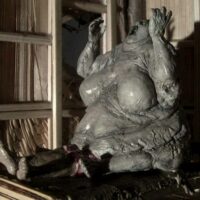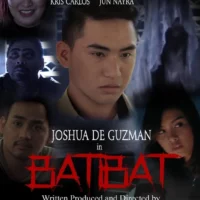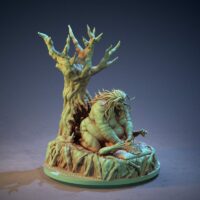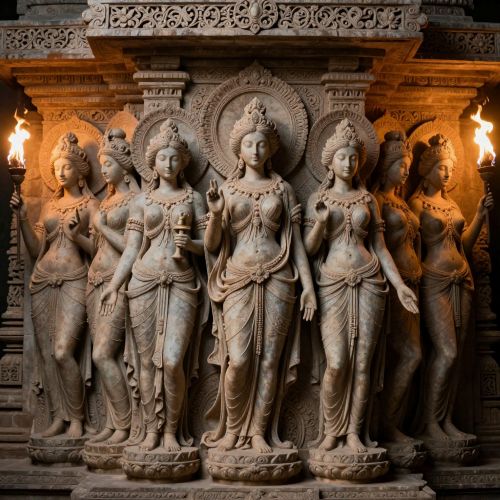Batibat : The Obese Spirit
Listen
At a glance
| Description | |
|---|---|
| Origin | Philippine Mythology |
| Classification | Spirits |
| Family Members | N/A |
| Region | Philippines |
| Associated With | Nightmares, Sleep Paralysis |
Batibat
Introduction
In the shadowy realm of Philippine mythology, the Batibat stands as one of the most terrifying spirits of Ilocano folklore. This corpulent, vengeful demon is believed to cause sudden unexplained deaths during sleep, often referred to as bangungot in Tagalog regions. Dwelling in the knots of old trees or within wooden posts used in home construction, the Batibat punishes those who disturb her dwelling. Her legend serves as both a supernatural warning and a symbolic reflection of nature’s retaliation when its sanctity is violated. While she is often invoked to explain fatal nightmares or nocturnal paralysis, the Batibat’s tale delves deeper into the Filipino psyche, capturing ancestral fears about sleep, spirits, and the fragile boundary between the physical and spiritual worlds.
Physical Traits
The Batibat is described as a massive, bloated, and grotesque female spirit. Her skin is thick and rough, her face wrinkled and aged, and her tangled hair hangs heavily over her shoulders. Unlike ethereal ghosts, the Batibat’s terrifying presence is physical — her weight alone is said to crush her victims. When she attacks, victims often feel an immense pressure on their chest, unable to move or cry out, as if pinned beneath her enormous form. This phenomenon mirrors what modern science calls sleep paralysis, but in folklore, it is the Batibat who suffocates the sleeper for invading her sacred tree or home. Her size and heaviness symbolize not only her physical oppression but also the spiritual burden of guilt and disturbance humans bring upon nature.
Family
Unlike gods or elementals that belong to divine lineages, the Batibat is largely solitary. She is not a creature of kinship but a force of vengeance — a guardian of trees and woodlands turned wrathful when disrespected. However, in the wider pantheon of Philippine lower mythology, she is often associated with entities like the Aswang, Bal-Bal, and Berbalang — nocturnal spirits that feast on the living or the dead. Together, they form an ecosystem of malevolent beings symbolizing death, nightmares, and punishment.
The Batibat’s isolation also emphasizes her symbolic role: she is a reminder of the consequences of destroying natural habitats and spiritual spaces. Her wrath personifies the idea that the spirit world must not be disturbed, lest humanity invite disaster.
Other names
The Batibat is known by several names throughout the Philippines. In Ilocano tradition, Batibat is the preferred term, while in Tagalog regions, her phenomena are often described as Bangungot — a word meaning “nightmare” or “death in sleep.” Though Bangungot now refers to a medical condition resembling sudden nocturnal death syndrome (SUNDS), its roots trace back to this mythic demon. The interchangeable use of Batibat and Bangungot illustrates the merging of folklore and real-life mystery in Filipino culture, where spiritual and physiological explanations intertwine.
Powers and Abilities
The Batibat’s powers revolve around dreams, sleep, and suffocation. She is notorious for sitting on the chest of sleeping humans, immobilizing them with her immense weight until they suffocate — a deadly manifestation of sleep paralysis. Her presence is said to cause vivid nightmares, distorted breathing, and a feeling of being crushed.
In some tales, she can manipulate shadows, distort the air, or induce hallucinations to torment her victims. Her influence blurs the line between the physical and spiritual realms, as she can attack both in the dream world and the waking state. Traditional remedies suggest that wiggling the toes or biting a thumb can break her paralysis, driving the Batibat away. However, the best protection, according to Ilocano elders, is respecting old trees and wood, never using sacred timber for homes without proper rituals.
Modern Day Influence
The Batibat remains a haunting figure in modern Philippine culture and beyond. Her myth continues to inspire horror films, short stories, and folklore studies. The 2020 Western horror film Evil Takes Root: The Curse of the Batibat introduced her legend to global audiences, portraying her as a demonic entity linked to sleep and possession. Meanwhile, Western pop culture references — such as a sleep demon in Chilling Adventures of Sabrina — clearly draw from her folklore.
In literature and media, she symbolizes the intersection of science and superstition — where sleep paralysis meets the supernatural. In rural Philippines, tales of her attacks persist, often serving as warnings to avoid cutting ancient trees or disrespecting ancestral spirits. Through oral tradition and modern reinterpretation, the Batibat remains an enduring symbol of vengeance, fear, and the unseen power of nature.
Related Images
Source
Jordan Clark. (2016). BATIBAT | BANGUNGOT – Frightened To Death By Nightmares. https://www.aswangproject.com/batibat-bangungot/
Contributors to Wikimedia projects. (n.d.). Batibat – Wikipedia. https://en.wikipedia.org/wiki/Batibat
Batibat | Myth and Folklore Wiki – Fandom. (n.d.). https://mythus.fandom.com/wiki/Batibat
batibat | Facts, Information, and Mythology – Encyclopedia Mythica. (1997). https://pantheon.org/articles/b/batibat.html
Ramos, Maximo D., Creatures of Philippine Lower Mythology, University of the Philippines Press, 1971.
Batibat – Monstropedia. (2010). https://monstropedia.org/index.php?title=Batibat
Frequently Asked Questions
What is the Batibat in Philippine mythology?
The Batibat is a vengeful female spirit from Ilocano mythology, believed to cause sudden deaths during sleep by suffocating her victims. Said to dwell in tree trunks or wooden posts used in homes, she punishes those who disturb her resting place. The Batibat represents both a guardian of nature and a bringer of death, embodying the ancient Filipino belief that the natural and spiritual worlds are deeply connected.
What does the Batibat look like?
The Batibat is described as an enormous, bloated woman with sagging skin, tangled hair, and a terrifying face. Her appearance is grotesque and oppressive, symbolizing the weight that crushes her victims as they sleep. Unlike ghostly spirits that float or fade, the Batibat’s haunting presence is physical—her bulk literally presses down on people’s chests, causing the sensation of sleep paralysis or even fatal suffocation.
Is the Batibat the same as Bangungot?
While the two are closely related, they are not exactly the same. The Batibat is the spirit or cause behind Bangungot, a Tagalog term referring to nightmares or sudden death during sleep. Folklore suggests that when a person dies from Bangungot, it is because the Batibat sat upon their chest, preventing them from breathing. This blending of myth and medical mystery reflects how Filipinos once explained sudden nocturnal deaths through spiritual causes.
How can you protect yourself from the Batibat?
Traditional belief advises avoiding the use of wood from old or sacred trees when building a house, as these might be home to Batibat spirits. If you experience sleep paralysis, folklore suggests wiggling your toes, biting your thumb, or praying aloud to break the spirit’s hold. Most importantly, people are warned to respect nature and ancestral spirits, as offending them could invite the Batibat’s deadly visit.
Does the Batibat appear in modern culture?
Yes. The Batibat has inspired numerous modern adaptations in film, literature, and online media. She appears prominently in the 2020 horror film Evil Takes Root: The Curse of the Batibat and has influenced Western depictions of sleep demons in shows like Chilling Adventures of Sabrina. In the Philippines, she remains a symbol of fear and respect for nature’s power—appearing in local ghost stories, urban legends, and even sleep-related folklore studies.













